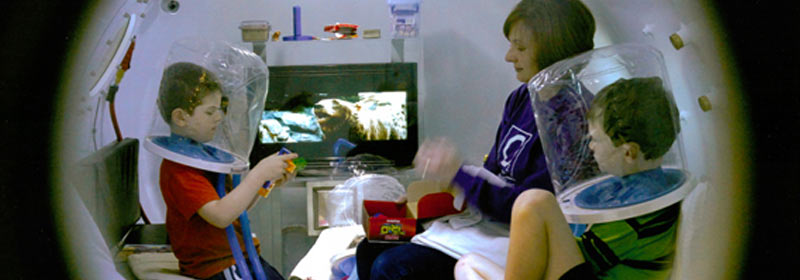Wauseon Nonprofit Delivers Hyperbaric Treatment
Article published Tuesday, March 20, 2012 by the Toledo Blade
WAUSEON — Northeast Ohio co-workers Laura Ramsey and Pam Haberkorn were trying gluten-free diets to help their autistic children when they learned of an alternative treatment showing promise in research: hyperbaric oxygen therapy.
In the summer of 2009, the teachers took their children to a private hyperbaric oxygen center in North Carolina to get the treatment, involving pure oxygen administered at higher than atmospheric pressure.
While in North Carolina, Katelyn Haberkorn, now 13, received two rounds of so-called dives and made remarkable progress, her mother said. Katelyn showed an interest in books for the first time and began talking more, making eye contact, and paying attention, Ms. Haberkorn said.
“When we learned about this, we had no idea what we were going to see,” said the mother of three from Medina. “She was bringing us books within a week, wanting us to read them.”
The two families since have found Sara’s Garden, a nonprofit center in Wauseon with two hyperbaric chambers, one with five seats and another with 10.
Such chambers have been used for decades, most commonly to heal wounds in diabetics and help divers with decompression sickness, but Sara’s Garden also treats patients with nonemergency ailments not covered by insurance and those who could not afford them elsewhere.
Each session costs $110 to $165 at the center staffed by five nurses and three chamber operators. A round typically involves 40 sessions, said Matthew Rychener, Sara’s Garden’s development director.
Sara’s Garden helps raise funds for treatments, and all patients must have a medical prescription and an X-ray, Mr. Rychener said.
Most hyperbaric clinics in Ohio and Michigan are associated with hospitals, although there are a few other independent facilities.
The Wauseon nonprofit organization got its start after Mr. Rychener’s sister Sara Burkholder died a few hours after her first child was delivered by emergency cesarean section a decade ago. Jackson Burkholder did not have enough oxygen during birth and was diagnosed with cerebral palsy, and his father, Jay, and other relatives researched treatments for him, Mr. Rychener said.
Hyperbaric oxygen treatment was an alternative Jackson’s family found was used in Europe for cerebral palsy, Mr. Rychener said. His nephew, he said, still has sessions at the center opened in 2005 that initially focused on treating children with cerebral palsy.
Cells receive more oxygen than normal during hyperbaric oxygen treatments, and blood vessels and nerves are built, Mr. Rychener said. One of his high school friends, Aron Sauder of Pettisville, did about 20 sessions to ease pain and speed the healing of his hands burned in a cooking fire in August.
“I was very happy with how it works,” said Mr. Sauder, 39, adding the area where skin was taken for grafting has healed.
So was Amanda Jarrett of Huntsville, Ala., a research analyst for a missile defense agency who grew up in Defiance. The 28-year-old was diagnosed with multiple sclerosis in July. After hyperbaric oxygen treatments helped alleviate many symptoms, she plans to return to Sara’s Garden periodically in hopes of slowing the autoimmune disease.
Mrs. Jarrett said she went on short-term disability and could not drive before getting hyperbaric oxygen treatments, which are used in the United Kingdom for multiple sclerosis. The numbness in her feet was so bad that the former ballet dancer could not point her toes, which she called heartbreaking, but she was able to resume driving after 20 sessions and now has about 5 percent numbness, she said.
“I felt like a 16-year-old who just got my license,” she recalled of being able to drive again. “Everything just continued to get better and better.”
Mrs. Jarrett, her husband, and another couple plan to start a nonprofit organization to raise money for patients who want hyperbaric oxygen therapy. They also plan to lobby the U.S. Food and Drug Administrative to approve usage for more conditions with the hopes that then more treatments would be covered by more insurance plans. An FDA spokesman did not return calls seeking comment.
Ms. Ramsey of North Ridgeville said her 8-year-old autistic son, Brendan Corrigan, looks forward to treatments because he feels better. So does Ms. Haberkorn’s autistic son, Kevin, 9, his mother said.
Meanwhile, Katelyn, who now has had more than 150 hyperbaric oxygen sessions, is a cheerleader and involved in a ski club, Ms. Haberkorn said. “It has been an amazing life change for our whole family,” she said.
Contact Julie M. McKinnon at: jmckinnon@theblade.com or 419-724-6087.



